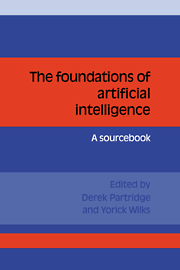Book contents
- Frontmatter
- Contents
- List of contributors
- Preface
- Acknowledgments
- 1 Introduction
- 2 The formal foundations of AI
- 3 Levels of theory
- 4 Programs and theories
- 5 The role of representations
- 6 The role of programs in AI
- 7 Rational reconstruction as an AI methodology
- 8 Is AI special in regard to its methodology?
- 9 Does connectionism provide a new paradigm for AI?
- 10 The role of correctness in AI
- 11 Limitations on current AI technology
- 12 Annotated bibliography on the foundations of AI
- Index of names
1 - Introduction
Published online by Cambridge University Press: 03 May 2010
- Frontmatter
- Contents
- List of contributors
- Preface
- Acknowledgments
- 1 Introduction
- 2 The formal foundations of AI
- 3 Levels of theory
- 4 Programs and theories
- 5 The role of representations
- 6 The role of programs in AI
- 7 Rational reconstruction as an AI methodology
- 8 Is AI special in regard to its methodology?
- 9 Does connectionism provide a new paradigm for AI?
- 10 The role of correctness in AI
- 11 Limitations on current AI technology
- 12 Annotated bibliography on the foundations of AI
- Index of names
Summary
The opening section presents two very different types of attempt to provide a general characterization of AI. For Schank, AI is a distributed phenomenon: ‘potentially … the algorithmic study of processes in every field of enquiry.’ In the absence of a definition, he characterizes AI in terms of a list of features that he considers to be critical. He argues that the the bifurcation of AI into a scientific and an applications track is so decisive that ‘the two routes have nothing to do with each other.’ Finally, he lists and briefly discusses ten problem areas in AI that will not admit of solutions in the foreseeable future.
Chandrasekaran's paper lays out in historical perspective the methodological paradigms within which AI projects and explorations have at different times, and in different places, been pursued.
He takes the opening shots at connectionism and the echoes continue throughout this book culminating in the papers of section 9. He also introduces the ‘symbolic’ paradigm (another recurring theme) and attempts to clarify the issue of ‘symbolic’ and ‘non-symbolic’ representations. He offers the ‘information processing level of abstraction’ as a unifying paradigm.
He presents and discusses, with the aid of representative examples, three classes of theories in AI: architectural theories, logical abstraction theories, and general functional theories of intelligence. The paper concludes with a clear preference for the last class of theories and offers a specific functionaltheory- type proposal about the nature of intelligence.
Within the discussion of the class of logic-based theories in AI, Chandrasekaran provides an overview and introduction to this important facet of the foundations of AI – the one that we deal with explicitly in the next chapter.
- Type
- Chapter
- Information
- The Foundations of Artificial IntelligenceA Sourcebook, pp. 1 - 2Publisher: Cambridge University PressPrint publication year: 1990

